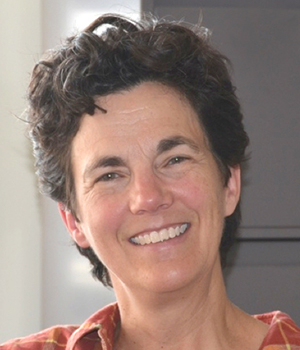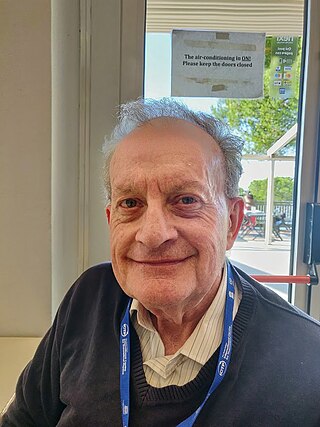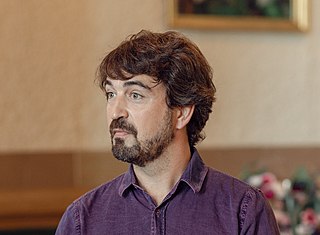Related Research Articles
A strange star, also called a strange quark star, is a hypothetical compact astronomical object, a quark star made of strange quark matter.

Frank Anthony Wilczek is an American theoretical physicist, mathematician and Nobel laureate. He is the Herman Feshbach Professor of Physics at the Massachusetts Institute of Technology (MIT), Founding Director of T. D. Lee Institute and Chief Scientist at the Wilczek Quantum Center, Shanghai Jiao Tong University (SJTU), distinguished professor at Arizona State University (ASU) and full professor at Stockholm University.

David Jonathan Gross is an American theoretical physicist and string theorist. Along with Frank Wilczek and David Politzer, he was awarded the 2004 Nobel Prize in Physics for their discovery of asymptotic freedom. Gross is the Chancellor's Chair Professor of Theoretical Physics at the Kavli Institute for Theoretical Physics (KITP) of the University of California, Santa Barbara (UCSB), and was formerly the KITP director and holder of their Frederick W. Gluck Chair in Theoretical Physics. He is also a faculty member in the UCSB Physics Department and is affiliated with the Institute for Quantum Studies at Chapman University in California. He is a foreign member of the Chinese Academy of Sciences.

Nima Arkani-Hamed is an American-Canadian theoretical physicist of Iranian descent, with interests in high-energy physics, quantum field theory, string theory, cosmology and collider physics. Arkani-Hamed is a member of the permanent faculty at the Institute for Advanced Study in Princeton, New Jersey. He is also director of the Carl P. Feinberg Cross-Disciplinary Program in Innovation at the Institute and director of The Center for Future High Energy Physics (CFHEP) in Beijing, China.

Leo Philip Kadanoff was an American physicist. He was a professor of physics at the University of Chicago and a former president of the American Physical Society (APS). He contributed to the fields of statistical physics, chaos theory, and theoretical condensed matter physics.

Helen Rhoda Arnold Quinn is an Australian-born particle physicist and educator who has made major contributions to both fields. Her contributions to theoretical physics include the Peccei–Quinn theory which implies a corresponding symmetry of nature and contributions to the search for a unified theory for the three types of particle interactions. As Chair of the Board on Science Education of the National Academy of Sciences, Quinn led the effort that produced A Framework for K-12 Science Education: Practices, Crosscutting Concepts, and Core Ideas—the basis for the Next Generation Science Standards adopted by many states. Her honours include the Dirac Medal of the International Center for Theoretical Physics, the Oskar Klein Medal from the Royal Swedish Academy of Sciences, appointment as an Honorary Officer of the Order of Australia, the J. J. Sakurai Prize for Theoretical Particle Physics from the American Physical Society, the Karl Taylor Compton Medal for Leadership in Physics from the American Institute of Physics, the 2018 Benjamin Franklin Medal in Physics from the Franklin Institute, and the 2023 Harvey Prize from Technion -- Israel Institute of Technology.

Ann Elizabeth Nelson was a particle physicist and professor of physics in the Particle Theory Group at the University of Washington from 1994 until her death. Nelson received a Guggenheim Fellowship in 2004, and she was elected to the American Academy of Arts and Sciences in 2011 and the National Academy of Sciences in 2012. She was a recipient of the 2018 J. J. Sakurai Prize for Theoretical Particle Physics, presented annually by the American Physical Society and considered one of the most prestigious prizes in physics.
David Pines was a US physicist recognized for his work in quantum many-body systems in condensed matter and nuclear physics. With his advisor David Bohm, he contributed to the understanding of electron interactions in metals. Bohm and Pines introduced the plasmon, the quantum of electron density oscillations in metals. They pioneered the use of the random phase approximation. His work with John Bardeen on electron-phonon interactions led to the development of the BCS theory of superconductivity. Pines extended BCS theory to nuclear physics to explain stability of isotopes with even and odd numbers of nucleons. He also used the theory of superfluidity to explain the glitches in neutron stars.

Witold (Witek) Nazarewicz is a Polish-American nuclear physicist, researcher, and educator. He is a John A. Hannah Distinguished Professor in Physics and Chief Scientist at the Facility for Rare Isotope Beams (FRIB) and the Department of Physics and Astronomy at Michigan State University, and a Professor at the University of Warsaw, Faculty of Physics, Institute of Theoretical Physics.
Gordon Alan Baym is an American theoretical physicist.
Steven Mark Girvin is an American physicist who is Sterling Professor and former Eugene Higgins Professor of Physics at Yale University. He is noted for his theoretical work on quantum many body systems such as the fractional quantum Hall effect, and as co-developer of circuit quantum electrodynamics, the application of the ideas of quantum optics to superconducting microwave circuits. Circuit QED is now the leading architecture for construction of quantum computers based on superconducting qubits.

Professor Bruce Harold John McKellar is an Australian theoretical particle physicist who is Honorary Professorial Fellow at the Centre of Excellence for Particle Physics at the Terascale (CoEPP) in the School of Physics at The University of Melbourne. The International Union of Pure and Applied Physics (IUPAP) elected him as its President-Designate in 2012. In November 2014 McKellar became President of IUPAP, the first-ever Australian to take on this role.

Vassiliki Kalogera is a Greek astrophysicist. She is a professor at Northwestern University and the director of the Center for Interdisciplinary Exploration and Research in Astrophysics (CIERA). She is a leading member of the LIGO Collaboration that observed gravitational waves in 2015.

Angela Villela Olinto is an American astroparticle physicist who is the provost of Columbia University. Previously, she served as the Albert A. Michelson Distinguished Service Professor at the University of Chicago as well as the dean of the Physical Sciences Division. Her current work is focused on understanding the origin of high-energy cosmic rays, gamma rays, and neutrinos.
Samarendra Nath Biswas was an Indian theoretical physicist specialized in theoretical high energy physics, particle physics and mathematical physics and is known for his work in several diverse areas.
Joshua A. Frieman is a theoretical astrophysicist who lives and works in the United States. He is a senior scientist at Fermilab and a professor of astronomy and astrophysics at the University of Chicago. Frieman is known for his work studying dark energy and cosmology, and he co-founded the Dark Energy Survey experiment. He was elected a member of the National Academy of Sciences in 2022.
Iain William Stewart is a Canadian-American theoretical nuclear and particle physicist at the Massachusetts Institute of Technology, where he is the Otto and Jane Morningstar Professor of Science and the current Director of the MIT Center for Theoretical Physics (CTP). He is best known for his work on effective field theories and for developing the Soft Collinear Effective Theory (SCET).

Nicolás Yunes is an Argentinian theoretical physicist who is a professor at the University of Illinois Urbana-Champaign and the founding director of the Illinois Center for Advanced Studies of the Universe (ICASU). He is particularly interested in extreme gravity, gravitational waves, and compact binaries.
Michael Cohen was an American condensed matter physicist and professor emeritus at the University of Pennsylvania. He worked on theoretical understanding of liquid helium, ferroelectrics, and biological membranes using quantum mechanics.

Manuel Linares Alegret is a Spanish researcher. He is an astronomer and astrophysicist, with a specialty in high-energy astrophysics. His primary focus is on compact objects in binary systems, neutron stars and accretion streams. In 2018, he and his research group discovered the most massive neutron star that had been measured until then. It has 2.3 times the mass of the sun.
References
- 1 2 "Physics - Mark G. Alford". physics.aps.org. Retrieved 2020-01-23.
- ↑ "Mark Alford". The Helix Center. Retrieved 2020-01-23.
- ↑ Sundermier, Ali (24 January 2017). "Five extreme facts about neutron stars". symmetry magazine. Retrieved 2020-01-23.
- ↑ "High density quark matter and color superconductivity". web.physics.wustl.edu. Retrieved 2020-01-23.
- 1 2 "Member Spotlight: Mark Alford, AM '88, PhD '90". hcstlouis.clubs.harvard.edu. Retrieved 2020-01-23.
- 1 2 "Mark G. Alford". Department of Physics. 2018-06-19. Retrieved 2020-01-24.
- ↑ "INSPIRE Author Profile - Mark Alford". INSPIRE HEP. Retrieved January 23, 2020.
- ↑ "Washington University Department of Physics" (PDF). GradSchoolShopper - American Institute of Physics. 2019.
- ↑ Alford, Mark. "Curriculum vitae" (PDF). Washington University Department of Physics. Retrieved January 23, 2020.